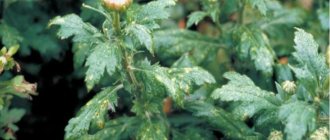Varieties for home
The chrysanthemum itself can be varied. From 15 cm to 1.5 m in height. But for indoor gardening, it is better to choose compact varieties. These are Chinese and mulberry.
Chinese chrysanthemum
A low bush, all covered with flowers, because of which the stems and leaves are invisible. As it grows, it forms flowering balls. Even a novice gardener can care for such a chrysanthemum in a pot at home. After purchase, it does not even require pruning.
Mulberry chrysanthemum
Larger form. The leaves reach a length of up to 7 cm. The lower part of the leaf has bluish fibers.
All flowers are collected in baskets. The center of the flower is always yellow, and along the edge –
petals of various colors.
Other varieties
The variety of chrysanthemums for the home is not limited to Chinese selection. A few more varieties:
- Korean spherical. Low-growing bushes shaped like a ball.
- Multiflora. Beautiful flowers that look like colorful pillows in pots.
- Cascade. Ampelous chrysanthemums. Look good in hanging flowerpots.
In addition to the listed species, other varieties, such as Indian ones, are also suitable for growing indoors.
Rules of care
Some aspects of caring for potted chrysanthemums at home differ from those generally accepted by gardeners.
We bought chrysanthemums, what next?
During the cold period, when the purchase is brought into the house, the flower is inspected. True, it would have been better to do this in the store.
If it’s warm outside, you can put the bush under the trees for a week, where there is diffused light, and observe.
If you see spots on the leaves, small insects, or other damage on the plant, you should remove the leaf blades and water the plant itself from a cool shower from all sides.
Illumination
Unlike many plants, chrysanthemums do not like direct sunlight. And flowering in many varieties begins when the day has already shortened by several hours. Therefore, a southern window sill or balcony is not suitable for flowers. It is worth placing the plant in the western or eastern direction.
Temperature
Chrysanthemum does not really like high temperatures. They should be no higher than 23 degrees in summer.
In autumn, when the main flowering time begins, on average – +
15.
In winter, you can display the flower on an insulated balcony, where it is not higher than +8, but not less than +3 degrees.
How to water
Watering is done only after the top layer of soil in the pot has dried. Moisturize well, but do not overfill; all excess water must be removed.
In very hot weather, it is worth placing a container of water next to the flower.
Winter care
In winter, the plant, like most others, goes dormant. There is almost no care for chrysanthemums in a pot at home during this period. Only flowers after purchase need more careful preparation for this process.
First you need to trim any flower, leaving about 10 cm.
Then moisten and place in a cool place: on a balcony, in a basement, in a very cold entrance or on a terrace, where it will remain until the end of March.
The chrysanthemum is periodically inspected. If necessary, water, but not earlier than after 3 weeks.
Transfer
Caring for a chrysanthemum in a pot at home after purchasing it in the spring begins with this.
Overwintered plants are also replanted.
- Select a pot larger than the previous one by 2-3 cm.
- It is washed thoroughly, then dipped in a solution of potassium permanganate for disinfection.
- They take special purchased soil or make it themselves by adding sand and humus to the garden soil.
- Apply organic fertilizers.
- The bottom is covered with expanded clay.
- Cover the top third with soil.
- Place the flower, straightening the roots.
- Fall asleep, not reaching half a centimeter from the edge, compact well and water.
Young plants need to be replanted every year, adults –
in a year.
Top dressing
After replanting, you can avoid fertilizing for 3 weeks if organic matter has been added. Then, by mid-summer, they begin to replace nitrogen with potassium and phosphorus.
Bush formation and decorative pruning
Produced after purchase some time later. When the chrysanthemum is brought from the store, it looks great because it is supported by stimulants. But a couple of weeks will pass, and the beautiful bush may crumble.
In this case, it is necessary to pinch off some stems, and the interfering plants inside –
delete.
If the cut branches are good, they are placed in water for rooting. The bad ones are thrown out.
Chrysanthemum propagation
If the chrysanthemum was bought in a pot and has taken root well at home, then after it blooms or in early spring, you can cut cuttings with 3 leaves and get young plants from them. For propagation, an oblique cut is made under the bottom leaf, above the top –
straight. The leaves are cut in half.
Prepare a soil mixture, the same as for replanting flowers. The branches are planted at an angle and moisten the soil well. The container is covered with polyethylene or a plastic transparent jar.
While the chrysanthemum is taking root, the plantings are inspected and ventilated so that there is no stagnation of moisture, which can lead to the development of fungal diseases.
Another way to get new flowers is to divide the bush when replanting.
The chrysanthemum is carefully pulled out of the container and the earth is shaken off. You can wash off the roots under running water. Then take a sharp knife, which must be disinfected in a solution of potassium permanganate or wiped with alcohol. They separate small parts of the plant from each other. The cuttings must have roots. The resulting bushes are planted in pots in the same way as during transplantation.
Chrysanthemum care and prevention
For a chrysanthemum growing in a pot indoors, competent care is extremely important, consisting of a whole range of measures, the implementation of which must be carefully thought out.
Temperature
It is obvious to everyone that dry air provokes drying of the leaves, but not all gardeners can provide optimal temperature conditions for chrysanthemums in a living room. The ideal range is from 10 to 15 ° C; at higher temperatures, the leaves turn yellow and the buds dry out. At a comfortable temperature, chrysanthemum grows faster and produces more buds . The plant will feel better in the heat if you create partial shade using curtains or blinds, and also provide constant access to fresh air, but without drafts.
Watering and humidity
Without timely watering, flower buds wither and dry out. The lack of moisture is felt by the dryness of the top layer of soil; optimal watering is once every 5 days. If the soil is dry, then the interval should be shortened; in hot weather, you can water twice a day. For irrigation, you should choose rain, filtered or settled water; you should not use hard water. Also, excess moisture should not be allowed, which leads to drying of the roots and leaves of the plant.
Another important procedure is spraying, which increases humidity for chrysanthemums that are accustomed to growing in outdoor conditions. For spraying, which is best done in the morning, it is important to use only filtered water so as not to damage the sensitive leaves.
Lighting
Chrysanthemums bloom when daylight hours decrease; 8-9 hours of light per day are enough for them. It is necessary to protect indoor flowers from direct sunlight. You need to stick to the golden mean and place the pot on the west or east side; on the south side the chrysanthemum will dry out.
The soil
The soil in which all parts of the chrysanthemum can feel comfortable should consist of approximately 70% nitrogen, it should also have a significant content of potassium, and phosphorus should be at a minimum.
The optimal composition of the earth mixture for indoor chrysanthemums, which can be made at home:
When planting and replanting, some gardeners add chicken manure to the soil. The soil should be constantly loosened and cultivated so that it does not roll into lumps, and all parts of the chrysanthemum grow evenly.
Timely replanting plays an important role in preventing the plant from drying out: for chrysanthemums under 5 years old - annually, for older specimens - 2 times a year. It is preferable to replant the plant in early spring, completely renewing the soil. It is necessary to follow the transplant rules:
- the diameter of the pot should be 2 cm larger than the previous one;
- drainage is required;
- there should be no voids in the earthen layer, but there is no need to add soil to the very top of the pot so that water does not spill during irrigation;
- Immediately after transplantation, chrysanthemums need good watering.
Fertilizer application
An important component of care is proper application of fertilizer; if mistakes are made, there is a high probability of leaves drying out and growth stopping. Rules:
- Fertilizing should begin 2 weeks after planting; if there is a lack of nutrients, if there are enough, then fertilizers should be applied no earlier than a month after transplanting;
- The optimal regime for applying fertilizers is 2 times a month;
- give nitrogen-containing fertilizers only during the growing season; if there are not enough of them, few inflorescences will appear;
- at the time of budding, apply potassium-phosphorus fertilizers, which give the flowers splendor, especially double varieties;
- It is necessary to take into account the variety of chrysanthemums when adding nutrients.
Nitrogen fertilizers are sometimes applied in the fall to promote root growth.
Trimming
It is important to trim the stems and leaves of chrysanthemums, because thickening does not allow air to circulate normally, which provokes unfavorable processes in the foliage.
To properly form a bush, the plant must be pruned as follows:
- cut the stems for the first time 2 weeks after planting;
- it is necessary to cut off the top, which has 3-4 leaves; if necessary, pinch the top regularly;
- process the cut areas;
- after sampling, add nitrogen fertilizer;
- pruning is contraindicated during the transplantation period;
- to speed up flowering, it is recommended to cut off small and weak buds;
- after flowering ends, the stems should be cut to 10 cm;
- Be sure to cut off diseased stems.
Thanks to pruning, the chrysanthemum will acquire a spherical shape. This pruning is carried out in the fall, after which the pot must be placed in a cool and dark place - a balcony, terrace, veranda - until spring. It is also necessary to get rid of old and wilted inflorescences in a timely manner; completely infected parts of plants should be burned without residue.
Problems of home chrysanthemums
Although indoor flowers are less often affected by diseases and pests, sometimes this cannot be avoided, especially immediately after purchase.
The following diseases may appear: gray rot, septoria, powdery mildew. They fight diseases with fungicidal drugs. Unfortunately, if the disease starts, the chrysanthemum has to be thrown away.
Aphids, thrips, and nematodes are frequent guests of flowers. They are sprayed with insecticidal agents: actelik, biotlin, actara.
A video of beautifully blooming chrysanthemums in a pot, grown at home, can be a wonderful component of some family holiday. To get the desired result, you just need to properly care for the flower at home after purchase. And the result will not be long in coming.
Chrysanthemum is a flower that goes well in bouquets with many other plants and looks great on its own. A huge number of shades allows you to delight and “pleasant the eye” of any person.
But there are times when a chrysanthemum in a pot begins to fade, causing misunderstanding and grief for the owner.
There may be several reasons for a flower to wilt:
- Too low or, conversely, high temperatures . At air temperatures above +25 and below -8, the flower may begin to fade.
- Incorrect watering . The flower should be watered when the top soil dries out by 1-2 cm and in no case consistently at certain intervals.
- Pests . Like many other plants, chrysanthemum can be susceptible to the proliferation of pests: whitefly, spider mites, gray rot, powdery mildew, septoria - these are a small part of the diseases and parasites characteristic of the flower.
- Bad soil . After purchase, it is recommended to replant chrysanthemums in new soil, since store-bought soil is considered transportable.
- Not timely care . If the plant has dried leaves, they must be trimmed so as not to cause the entire flower to wither.
- Improper soil fertilization . Only healthy plants should be fertilized. If you notice signs of flower wilting, do not add fertilizer to the soil under any circumstances.
Why do chrysanthemums turn yellow?
Yellowed chrysanthemum leaves may indicate improper care or the appearance of parasites on the plant. If the leaves turn yellow and begin to wither:
- Adjust watering. Excessive watering leads to rotting of the root system
- Check the plant for spider mites that are sucking moisture from the plant
How to properly replant a chrysanthemum
A chrysanthemum bought in a store needs to be replanted, but following certain rules:
- The flower needs to be allowed to get used to the new living conditions. After purchasing, do not replant the flower immediately, but give it 1-2 weeks to adapt.
- Replant the plant in a pot of the same size or 1-2 cm larger. A new pot that is too large can cause wilting.
- Having taken the flower out of the pot, shake off the soil, carefully, without damaging the roots, remove most of the soil.
- Use the same type of soil as when you purchased it (flower, street, peat, etc.)
- Do not water the flower immediately after transplantation, do it after a few hours. In addition, after the first watering, the soil will become compacted; if necessary, it will have to be added.
- Make sure that after transplanting all the roots of the flower are in the ground. Otherwise, they may rot, which can subsequently destroy the entire flower.
Why don't homemade chrysanthemums bloom?
The reasons for the lack of flowering of domestic chrysanthemums may be the same as wilting, but the main ones are:
- The soil is too rich in nitrogen. In this case, the plant gains height well, bushes well, but does not produce the long-awaited flowering. It is recommended to use special fertilizers containing large amounts of potassium and phosphorus.
- Light mode. Chrysanthemum flowering begins in autumn, when daylight lasts about 8 hours. You can artificially provoke the appearance of buds if, in the summer, you cover the plant with a dark cap, for example, made of cardboard.
- Improper care and living conditions.
With the onset of autumn, the counters of flower shops delight the eye with an abundance of varieties planted in small pots of chrysanthemums. Sometimes they are bought instead of a bouquet and thrown away after flowering. And completely in vain. A chrysanthemum in a pot can grow successfully on a windowsill for many years and become one of the best decorations for a home mini-greenhouse. And if you don’t want to keep this autumn beauty at home, you can transplant it to your dacha in open ground when spring arrives.
Causes of dried leaves
Chrysanthemum leaves and buds dry out for a number of reasons: among them diseases, pest attacks, mistakes made during care. It is important to have an idea of the symptoms of a particular disease in order to take action at the initial stage and prevent chrysanthemums from drying out completely.
Gray rot
The causative agent of gray rot is a fungus that begins its journey through the plant from the roots in the ground; its appearance is often promoted by improper watering and an erroneous fertilizer application schedule. First, the leaves and stems become gray-brown due to the attack of gray rot, then a kind of coating forms, and at the final stage the leaves dry out and fall off. The danger of gray rot is the possibility of death of flowers.
Read also Options for insulating a wooden house
Powdery mildew
This common phenomenon also occurs as a result of the negative effects of fungus. Factors contributing to the appearance of powdery mildew are abundant watering and prolonged rain. The primary symptom is a white coating on the leaves, which soon darkens. With further development, the disease spreads to the buds, and they dry out.
Spider mite
This harmful insect can be found on chrysanthemums sold in stores; you must carefully examine the leaves for the presence of cobwebs on the inside of the leaves. Mites suck out the juices of the plant, as a result of which the leaves wither and dry out, turning into lifeless tubes.
Spider mites quite easily gnaw through the delicate tissue of leaves and suck out liquid
Brown aphid
A harmful insect that attacks chrysanthemum leaves from the underside, causing them to turn yellow, dry out and fall off. Aphids do not allow the buds to open; they wither and dry out. Brown aphids spread due to a virus entering the plant.
Weevils and Saricides
The weevil is an insect with a peculiar long nose; the insect attacks flower buds, causing them to dry out. Saricides also prefer to settle in chrysanthemum buds; they are attracted by high humidity and rotting food debris. Weevils and sarcids come to life when daylight ends and the room is plunged into darkness.
Trips
One of the main signs of the appearance of the thrips pest is the appearance of spots on the leaves that change their color from red to dark brown. Thrips has a negative effect on the shape and development of leaves: they dry out and become deformed.
Slobbery Penny
The presence of this insect on chrysanthemums can be determined by the presence of foam on parts of the plant. Its formation is facilitated by high humidity, high room temperature, and the flower being kept in greenhouse conditions for a long time without ventilation. The slobbering frog has a destructive effect on the leaves - they darken, dry out and fall off.
Nematodosis
The disease is caused by thread-shaped worms that settle in the soil; they are difficult to notice with the naked eye. The main blow falls on the leaves, which darken, dry out and crumble over time. If the nematodes have affected the buds, the inflorescences will also darken and dry out in the future. Immediate transplantation of the diseased plant from healthy ones is required.
Septoria
This fungal disease manifests itself in the formation of brown spots on the leaves, which gradually turn black. Also, these spots increase extremely quickly in size, occupying the entire area of the leaf that dries out. To save the flower, you need to cut off the infected leaves; if this is not done, you will have to get rid of the entire plant.
Ascochyta blight
With this disease, the fungus spreads from the lower leaves, gradually affecting the entire leaf blade, on which mottling forms. Often such leaves rot and dry out. If ascochyta blight is detected, the only way out is to burn the diseased parts of the chrysanthemum.
Fungal disease ascochytasis
Improper care
If the leaves of an indoor chrysanthemum dry out, then you need to check whether the care is carried out correctly. Popular causes of dried leaves include:
- sudden changes in temperature negatively affect the condition of a flower standing in a pot on the windowsill;
- room temperature is too high or too low;
- dry air that dries indoor chrysanthemums standing next to the radiators;
- excessive watering, which negatively affects the condition of the leaves;
- increased amount of nitrogen-containing fertilizers.
Homemade chrysanthemum: which varieties are suitable for growing in pots
Looking at chrysanthemums in flower beds, many gardeners wonder whether these beautiful flowers can be grown indoors. Of course you can! Growing a chrysanthemum in a pot is not at all difficult, you just need to choose the right variety and provide the flower with comfortable living conditions, and then homemade chrysanthemums in pots can decorate the interior of an apartment or office.
Often, indoor varieties of chrysanthemums are grown with the help of growth-inhibiting drugs. Thus, they turn out to be low-growing, just suitable for a flowerpot.
The following varieties of perennial chrysanthemums are best suited for growing in an apartment or house:
- Chinese - hybrids with beautiful double inflorescences;
- Korean - unpretentious varieties with inflorescences of different shapes and sizes;
- Indian - greenhouse varieties, most adapted to indoor growing;
- most are dwarf chrysanthemums, called border chrysanthemums.
As an indoor flower, the “queen” of the autumn garden has been cultivated for many years, and the question of whether this beauty can be kept at home has ceased to be relevant. The florist only has the task of choosing the most interesting variety for him, the decorative quality of which he can preserve after purchase and flowering.
Chrysanthemums in pots: how to care
Most varieties of chrysanthemums begin to bloom in autumn, when the air temperature drops. Coolness promotes long-lasting flowering. The same conditions arise at the beginning of spring, and many gardeners artificially provoke chrysanthemums to bloom again during this period.
In order to properly care for a potted flower, it is important to know the main features of its agricultural technology. The main things to pay attention to are:
- Care after purchase. It consists of adapting the green beauty to new conditions and then replanting it in suitable soil. Before replanting the chrysanthemum into a new pot, store purchased bushes for 2-3 weeks in a warm, well-lit place.
- The soil. When choosing a planting substrate, it is important to understand what kind of soil is needed for chrysanthemums. The soil for indoor beauty should be nutritious and loose. This can be ready-made soil for flowering crops or any other micronutrient-rich, not too acidic substrate.
- Lighting. For the harmonious development of this potted culture, long daylight hours are needed. It is better to place it on the eastern window, where there is usually the most light, and on especially hot and sunny days, shade it to avoid sunburn. The optimal growing temperature is 18-23° C.
- Watering. The most important thing in how to water a chrysanthemum is to maintain a constant balance, without flooding or drying out the soil. Watering chrysanthemums in a pot should be frequent, but not excessive. Stagnant moisture at the roots can provoke the development of fungal diseases, and a lack of water will adversely affect the appearance.
- Feeding. Profusely flowering varieties need to be fed regularly: every week during the entire flowering period. Other varieties need fertilizer less often - 1-2 times a month. You can feed the chrysanthemum with any complex preparation containing nitrogen, phosphorus and potassium.
- Trimming. Timely pinching and pruning help to form a neat bush. Before pruning the plant, you need to carefully examine it, selecting shoots that grow crookedly, deviate to the sides, etc. They need to be carefully trimmed or pruned, after which the resulting cuttings can be sent for rooting. During pruning, wilted buds, dry leaves and stems are also removed.
Most often, pots with indoor varieties of chrysanthemums feel great on windows facing west or east. This arrangement will allow you to get the necessary 8-10 hours of daylight and protect you from direct sunlight.
It is imperative to regularly care for your homemade green beauty, otherwise it will quickly lose its decorative value.
How to trim a chrysanthemum
Pruning involves removing the upper part of the stem, due to which the growth of the plant slows down, the root system develops, and side shoots appear:
- Start pruning 10-15 days after planting.
- From a stem 12-15 cm long, cut off the upper part of the plant with 3-4 leaves with a sharp knife or pruning shears.
- After pruning, water the plant with nitrogen fertilizer.
- 2-3 weeks after pruning, shoots form in the leaf axils.
Read more: How to stop a ferret from biting, why does it bite?
Do not prune during transplantation.
After flowering, chrysanthemums must be pruned. Step back 5-10 cm from the soil surface and use pruning shears to cut off the stems of the plant.
If you notice that the plant is damaged by aphids, cut off the diseased stems. Healthy plants cannot be pruned after sick ones with the same tool.
After pruning, the plants are removed to a cool (no more than 5°) dark room until spring. Pruning is necessary. The plant will rest and gain strength for better growth and flowering. During rest, the plant should be watered occasionally.
You can postpone the rest period if the bush is healthy and strong enough:
- Trim the plant and transplant it into a larger container. Completely replace the old substrate with a new one.
- Place the chrysanthemum in a bright, warm place, temperature from 18° to 20°.
- Water the flower 2-3 times a week.
- Feed with nitrogenous fertilizer once every 2 weeks.
- After the first buds appear, feed the plant with potassium-phosphorus fertilizer.
With proper care, the chrysanthemum will bloom in 2-2.5 months. But after flowering it must be sent to rest.
Chrysanthemums need to be trimmed after flowering. During this period, it is necessary to remove all regrown stems without affecting the young shoots. In spring, pruning is also recommended before replanting. The rest of the time, to extend the flowering period, you just need to remove the yellowed leaves of the plant.
What pot is needed for indoor chrysanthemum
When choosing a suitable container for growing chrysanthemums at home, you need to consider the following nuances:
- the plant has a shallow root system, so it cannot be planted in narrow and high pots. At the same time, flat, wide bowls are also not the best option: it is difficult to organize good drainage in them, which is so necessary for proper air exchange of thin and delicate roots;
- when replanting, the new pot should be slightly larger than the previous one so that the root system has room to develop;
- chrysanthemums can be grown in pots and flowerpots made of any material, but they look especially impressive when kept in massive clay or ceramic pots.
How to transplant a chrysanthemum from pot to pot
Chrysanthemums do not live long in the same pot. It is recommended to replant young bushes once a year (in addition to the first replantation after purchase), adults - once every 2-3 years. In addition, a transplant is required in the following cases:
- the flower was recently purchased and is in a temporary container;
- the bush became cramped in the old container;
- the soil in the pot is depleted of nutrients;
- Parasites or fungi have settled in the soil.
Before replanting an indoor chrysanthemum, it is necessary to assess its condition. If the plant is healthy, it is simply transferred from pot to pot along with a lump of earth (this way the root system is less damaged). Then the new container is filled with fresh soil. For sick and pest-infested specimens, the soil is changed completely, carefully shaking it out from the roots. When planting, it is important to remember to add a good layer of drainage to the pot.
Diseases
This delicate plant often suffers from viral, fungal and bacterial infections, as a result it loses its decorative properties and dies.
Septoria
The first signs of fungal infection are the appearance of black spots on the surface of the foliage. The edges of the leaf blade turn yellow. At an advanced stage, the leaves completely turn black, dry out and fall off.
On diseased specimens, all affected organs are removed to prevent infection of healthy plants. Treatment is carried out using systemic fungicides - Bordeaux mixture, Fundazol or Topsin-M. During the treatment period, reduce watering.
Severely affected specimens are removed from the site and burned.
For preventive purposes, a distance should be maintained between plantings to prevent their thickening and the appearance of the pathogen.
Ascochyta blight
A fungal disease that first affects the foliage, then spreads to other organs of the flower - shoots, flower buds.
Signs are the appearance of gray-brown spots on the surface of the leaves. Over time, the spots merge and the leaves turn completely black, dry out and hang drooping on the stems. Flower buds may become covered with black specks, and their core begins to rot.
As with septoria, affected areas should be torn off and disposed of to prevent infection of nearby healthy plants.
For treatment, systemic fungicides are used - Bordeaux mixture or copper sulfate.
Gray rot
One of the most common fungal diseases of this plant, which often appears during the cold season, as well as during the flowering period. The entire above-ground part of plants is affected. A fluffy gray-white coating forms on the foliage, shoots, and flowers; the next stage is the appearance of watery brown spots. At an advanced stage, the infected areas rot.
Both adult and young specimens are susceptible to damage; plants rooted from cuttings are especially vulnerable. The leaves dry out first, then the rest of the plant organs. A chrysanthemum that has dried out should be removed from the site and burned.
Irrigation of diseased specimens is carried out using fungicides - Topsin-M, Horus, Fundazol, Trichodermin and Mikosan.
For the purpose of prevention, chrysanthemums growing at home and in greenhouses should optimize care - provide good lighting and a stable temperature within 18-22 ° C.
Powdery mildew
This disease is difficult to confuse with some other type - it manifests itself in the form of a powdery white coating on the entire surface of leaves, shoots, and flowers. Over time, the plaque becomes gray, then dark brown. If measures are not taken in time, the plant will form undeveloped flower buds or will not bloom at all.
Simply removing blackened and dried leaves cannot save the plant; it is necessary to treat it with pesticides - Fundazol, Topsin-M, Bordeaux mixture, Medex, Azophos or copper oxychloride.
These drugs are also used for preventive purposes. Foliar treatment is carried out at the beginning of the growing season, then two weeks after the first treatment and two weeks before flowering.
When using such products, strictly follow the dosage indicated on the packaging so as not to destroy the plants at all.
For prevention purposes, you should maintain a distance between plantings, and also remove weeds and remnants of last year’s vegetation from the site in a timely manner.
Baldness and drying out of inflorescences
Young specimens obtained from already infected uterine bushes are predominantly affected. Inflorescences and leaves do not develop fully and gradually dry out. This phenomenon is not typical for all varieties of chrysanthemums.
The main reason is the lack of fertilizing or improper feeding of the bushes at the stage of leaf development and flower formation.
The problem can be eliminated - only healthy specimens should be selected for cultivation and fertilized correctly and regularly with complex preparations.
Rust
This fungal infection appears as red spots on the undersides of foliage. The top of the leaf blade is covered with pale spots. With severe damage, plants stop growing and blooming.
Prevention and treatment are as follows:
- removal of affected areas;
- eliminating crowded plantings by removing excess plants;
- during watering, it is important that water does not fall on the leaves and shoots;
- in case of severe damage, systemic fungicides should be used.
Fusarium
The first signs of Fusarium wilt of foliage are the appearance of yellowness and brown spots on the surface of the leaf blade. Infected specimens are often stunted in growth, stop blooming, and the leaves on the stems gradually dry out. The fungus first attacks the root system, then spreads to the above-ground parts of the plants.
For preventive purposes, diseased specimens should be promptly removed from the site and fusarium-resistant varieties should be used for planting.
If there is a fungus in the soil, a procedure should be carried out to increase the acidity to a level of 7 units.
Mosaic
This is a viral infection, when affected, plants look stunted, underdeveloped, and the leaves begin to turn yellow and dry out en masse. Such specimens form ugly and small flowers.
For prevention, it is necessary to promptly remove the affected organs on plants, and also regularly fight against weeds in which the virus starts.
To combat mosaic, fungicides are used - copper sulfate or Bordeaux mixture.
Nematodosis
First, pale whitish spots appear on the leaves; in a short time they darken and turn black. Affected leaves dry out and fall off. Flower buds are also affected, resulting in the plant forming undeveloped inflorescences.
The causative agent of the disease is a white thread-like worm that lives in the soil. To combat nematodes, soil is treated with Formalin.
For prevention purposes, healthy planting material should be used, and heavily infected flowers should be immediately removed and burned.
The chrysanthemum in the pot has faded, what to do next?
When the flowering time ends and the dormant period begins. This is an extremely important time of the year for the plant, when it rests and gains strength before the new active season and the question of what to do next with the chrysanthemum in the pot becomes relevant.
To extend the flowering period, it is necessary to remove dried leaves and flower buds from time to time. On hot days, the flower is placed in a cool place.
After the chrysanthemum in the pot has bloomed, all its shoots must be cut off, leaving “stumps” no more than 15 cm high. For the winter, the plant needs to be put in a cool but well-lit place and watered regularly, but very sparingly: only enough so that the bush has enough strength to “survive” until spring.
A home flower can overwinter on the same windowsill where its growing season took place. In this case, care for it is carried out according to the same rules as before. And to prevent the shoots of a faded potted chrysanthemum from stretching out, it may need additional lighting.
Diseases and pests of chrysanthemum
Chrysanthemums, like other indoor flowers, are the object of love for many parasites and diseases:
- Spider mite. If cobwebs are detected on the leaves, the entire surface of the plant is treated with a soap solution, and then washed under warm water in the shower.
- Powdery mildew. A fungus in the form of a gray coating on the leaves of a plant. It is eradicated using a fungicide and quarantining the plant in a dry room.
- Gray rot. It appears as a fluffy layer of gray color on the sheets. You can remove it by spraying the leaves with foundationazole.
- Septoria. It looks like a brown spot on a plant leaf. The plant needs to be watered less and treated with foundationazole.
How to propagate home chrysanthemum
Many gardeners mistakenly consider chrysanthemum growing at home to be an annual plant, and throw it away after flowering. But this is a big mistake. The chrysanthemum bush can be preserved and subsequently propagated.
Indoor chrysanthemums are usually propagated by cuttings. Planting material is obtained during formative pruning of the crown: powerful stems are shortened by 10-15 cm, cut cuttings are planted in a moist substrate and the container is covered with film or glass. The greenhouse is regularly watered and ventilated. After the roots appear, the cuttings are planted in pots of suitable size and then cared for in the same way as adult plants.
Propagation by cuttings is the most effective, affordable and fairly simple way to obtain new bushes, which cannot be said about growing from seeds at home. The seed method requires patience and attention and often does not guarantee obtaining specimens that fully preserve the individual characteristics of the variety. Before propagating chrysanthemums indoors with seeds, you must understand: using this method makes sense only when cuttings for some reason are not possible.
Potted chrysanthemums: planting in open ground
In the warm season, indoor chrysanthemums will benefit from being on the balcony or in the garden. If you want to effectively decorate your flower beds, transplanting chrysanthemums from a pot into the ground is not at all necessary. You can simply take them out onto the terrace in beautiful flowerpots and flowerpots, or dig them into the garden directly in pots, and take them back home when the cold weather arrives.
If possible, all indoor chrysanthemums can be planted in open ground in the summer. There they will gain strength, and after being transplanted into a pot in the fall, they will decorate the room with lush blooms until the New Year.
When the question of how to transplant chrysanthemums from a pot into the ground is still relevant, the main thing that needs to be done is to choose the right planting site. The better it is lit, the more comfortable the flower will be in open ground. The time when you can transplant the bush outside comes when the last morning frosts have passed. The soil must be warmed up to at least +14 °C. In this case, adaptation to new growing conditions will be faster.
Why does chrysanthemum not bloom at home?
You can explain why a chrysanthemum in a pot does not bloom by the presence of the following errors in planting and care:
- Poorly organized lighting. To form buds, the plant needs to be in the light for at least 8 hours a day.
- Untimely pruning and pinching. Buds appear on young shoots, so to revive and rejuvenate the bush, it needs to be trimmed regularly.
- The buds do not bloom due to lack of nutrition. Cultivation takes place in soil depleted of useful substances (the problem is solved by regular complex fertilizing).
By eliminating these reasons, you can make the bush bloom amicably and abundantly. And in order not to be tormented every autumn by the question of why chrysanthemums do not bloom, it is important to initially correctly organize all the conditions for their cultivation.
Why do chrysanthemum buds dry out?
Many gardeners love chrysanthemums because they decorate the garden until late autumn. But it happens that the chrysanthemum does not bloom and the gardener does not know what to do.
Why does chrysanthemum not bloom in the garden:
- Lack of space. If the bushes are planted too densely, they will not have enough nutrients and moisture to form flowers.
- Wrong location. Bushes planted in shaded areas or low areas will not bloom. In lowlands there is often high soil moisture, which causes the roots to begin to rot.
- Poor soil. If chrysanthemum grows in open ground, you should take care to enrich it with nutrients. This will help the plant to bloom.
Another common reason for the lack of flowers is chrysanthemum diseases.
Yellow leaves spoil the appearance of the bush and indicate a disease. Therefore, it is necessary to solve this problem as quickly as possible.
Why do the leaves of chrysanthemums in a pot turn yellow? If this happens, it is worth trying drainage. Perhaps the soil is too dense and moisture does not penetrate to the roots. Another reason is that the pot is too small, causing the plant to lack the necessary nutrients.
Yellowing of the leaves is also caused by diseases of garden chrysanthemum such as rust and septoria.
Advice! If the leaves of a chrysanthemum in the garden turn yellow, it is worth inspecting the plant for diseases and assessing the conditions. Perhaps the chrysanthemums should be transplanted to a higher place or the watering regime should be changed.
Light brown spots indicate a disease such as gray rot. The main reason is lack of air, which occurs if the bushes are located too close to each other. To prevent the disease, bushes are sprayed with copper-based preparations. It is also important to choose the right place for planting.
Black spots on chrysanthemum leaves are a sign of septoria. The causative agent of this disease lives in last year's foliage. For prevention you should:
- Do not plant plants too densely;
- Regularly thin out bushes;
- Remove diseased leaves;
- Avoid overwatering.
If the buds dry out, the reason may be:
- Failure to comply with proportions and regularity when applying fertilizers.
- Drying out of the soil or, conversely, excessive moisture.
- Damage from harmful insects.
Mites, for example, like a dry environment, but weevils like well-watered flower pots. Both of them gnaw the flower buds, causing the latter to dry out.
Diseases of indoor chrysanthemum
Potted chrysanthemum is quite hardy and not at all capricious. But it can also be threatened by diseases and pests typical of most indoor plants. And if you don’t start fighting them in time, the flower dies very quickly.
Pests
The main pests of indoor plants that gardeners may encounter are:
- Spider mite. It is dangerous because it very quickly sucks out all the juices from the ground part of the flower, as a result of which it withers and dies. The presence of an insect is signaled by the appearance of thin cobwebs on the lower parts of the leaves. Experienced flower growers know how to save a chrysanthemum in a pot from this trouble. To prevent spider mite infection on hot days, the bushes are periodically sprayed with clean water. At the first sign of a pest, the leaves are treated with a weak soap solution. If the mite has managed to spread throughout the entire bush, only special insecticidal preparations (Fitoverm, Akarin, etc.) will help get rid of it.
- Field (meadow) bug. You can even detect this parasite on a home chrysanthemum with the naked eye: the field bug is gray-green in color, reaches a length of 0.5 cm and settles on the leaves. The insect draws juices from the above-ground parts of plants, which leads to yellowing and curling of the leaves. Specimens affected by bedbugs stop blooming and develop poorly. If the bugs have not yet had time to breed, they are destroyed along with the affected foliage; in case of severe infestation, they are treated with insecticides.
- Aphid. Another pest that feeds on plant sap and reproduces very quickly. The invasion of these parasites can completely destroy a flower in a short time. Aphids appear on domestic chrysanthemum if the bush is regularly watered. You can fight it mechanically, promptly tearing off leaves and stems with signs of infection, but a more effective method of treatment is the use of modern insecticidal preparations.
Ways to solve the problem of drying leaves
There are several effective methods to help prevent dryness of chrysanthemum leaves, each of them can be used after the cause of the disease has been accurately determined. In some cases, all that remains is to destroy the flower if there is a threat of infection of neighboring plants.
Fighting fungus
Fungus is one of the most common misfortunes that causes dry leaves. It is necessary to tune in to regular, at least 3 times a year, preventive measures for treating with fungicides:
- Foundationazole;
- copper sulfate;
- Bordeaux mixture;
- Azophos.
The dose of fungicides must be precisely adjusted - any excess is dangerous. Application of an increased dose is allowed during the growing season. When spraying, you must not forget about the soil - microorganisms live there that have a destructive effect on flowers. With a progressive disease, the diseased parts or the entire plant must be burned.
Fighting the virus
The virus is often the causative agent of dangerous diseases; it is often carried by insects, the presence of which has a destructive effect on chrysanthemums. You can protect yourself from viruses by preventive spraying:
Folk remedies are also indispensable:
- tobacco infusion;
- garlic solution;
- hot pepper infusion.
Insect control
Many insects settle en masse on chrysanthemums, attacking all parts of the flower. Some spoil the chrysanthemum so much that they often have to get rid of the entire plant. To avoid this, it is necessary to regularly inspect all parts of the flower, paying close attention to the lower leaves - this is where the pests begin their journey.
High-quality insecticides can cope with most insects (ticks, weevils, saricides); treatment should be carried out 3 times with an interval of 5 days. Actelik is the most effective against spider mites. Water procedures also help fight mites - it is useful to place a pot under the shower. But excess moisture is harmful if worms or flies are found on chrysanthemums.
Read also How to take a shoot from a ficus photo
Actellik is an effective but toxic agent that helps in pest control.











